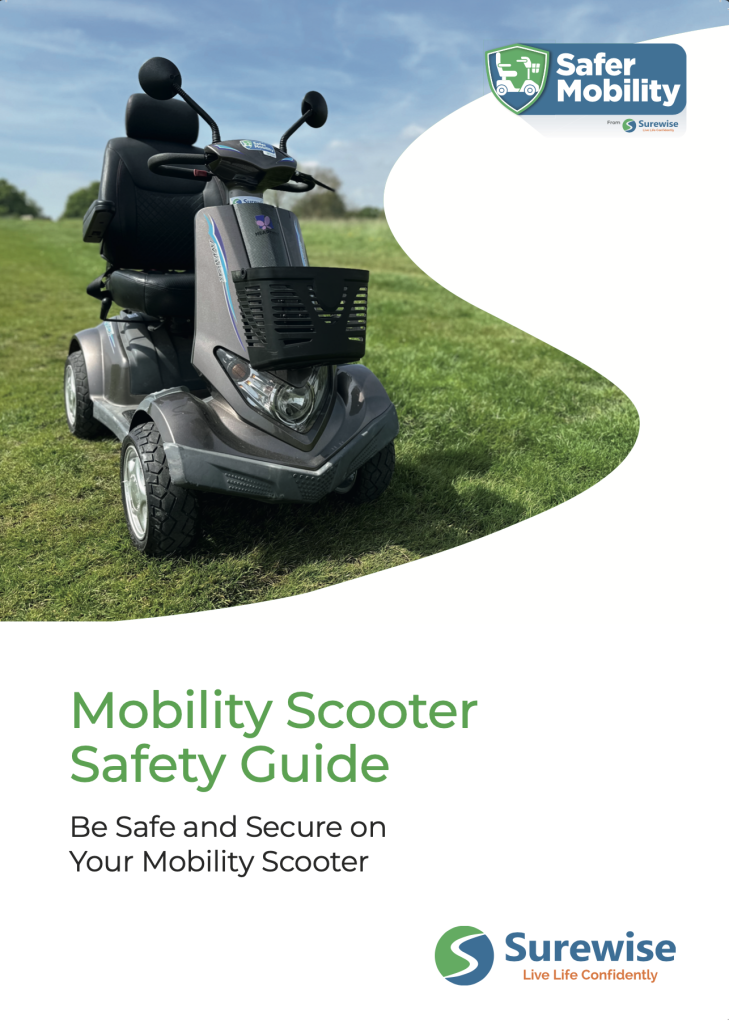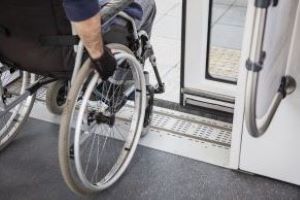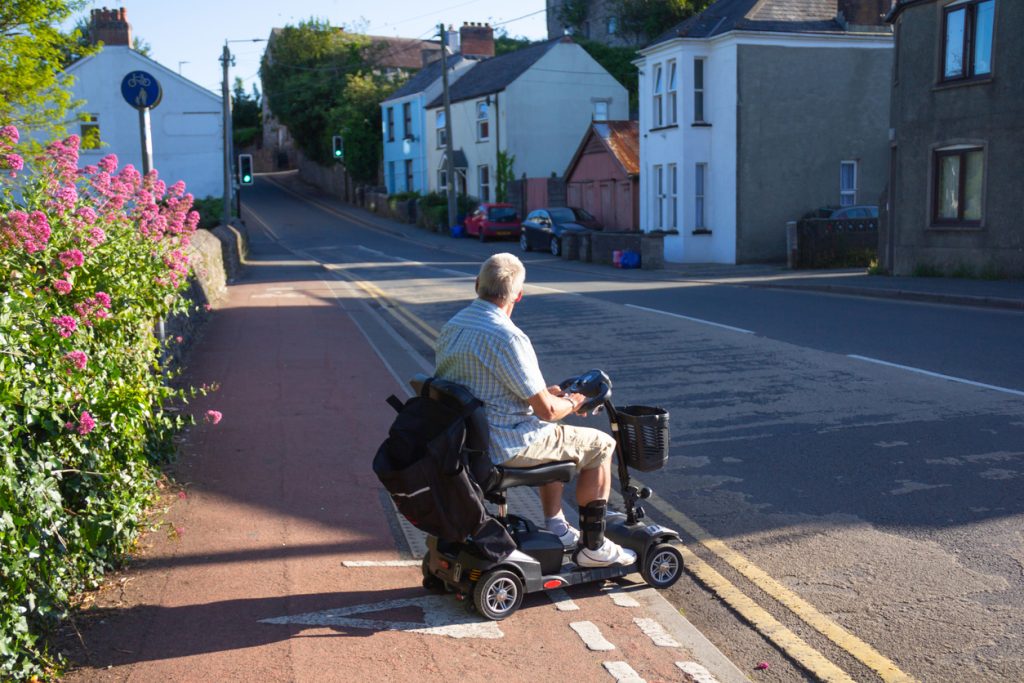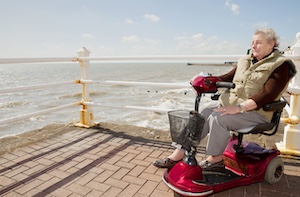Mobility scooters can change people’s lives, giving people with limited mobility a new lease of freedom and independence, as well as a host of other benefits.
However, it’s essential that you understand how to use your scooter safely in order to stay safe and get the most out of it.
Along with this post, we have produced a free Mobility Scooter Safety guide in PDF format. It’s downloadable, printable and most importantly completely free, in order to help you enjoy your Mobility Scooter as safely as possible.
Read more about our Safer Mobility campaign and the work we’re doing to raise awareness on keeping mobility scooter drivers safe when using the roads.

In this mobility scooter safety guide and the post below, we’re going to look at some important safety tips to keep your engine running through rain and sun, sleet and snow, heat and cold.
Table of Contents:
- Finding the right scooter for you
- Learning to use your scooter
- Practising for your safety
- Maintaining your scooter
- Being visible on the roads
- Route planning
- Loading your scooter safely
- Who’s right of way and when?
- Licences and the law
- Other common-sense tips you might need to know
1. Find The Right Match For Your Needs
To start with, you should only buy a mobility scooter after getting advice from an occupational therapist. They will advise you as to what kind of scooter will match your exact mobility needs.
You could also ask a reputable dealer – but be aware that dealers may be bound to supply a particular manufacturer over others, so it’s a good idea to have done some research beforehand. This is not always the case, but if you’re not going to see an occupational therapist then chat to at least two or three dealers to get a clearer view of scooters available to you.
You can also get information on the various accessories available. Depending on your physical needs and desired comfort level you could get a memory foam or air cushion, an attachment for your cane or walking stick, a headrest, safety straps, oxygen carrier, and calf straps. There are also various high-viz options, including straps and vests, for additional safety in inclement weather conditions.
A few accessories and parts that are perhaps more necessary than others include a battery charger, scooter cover, control panel cover, anti-theft alarm, rear storage bag or lockage box, and front basket.
2. Know The Features Of Your Scooter – Before You Drive Away!
A key part of mobility scooter safety is to make sure you understand how your new scooter works before you drive it off the shop floor. The manual has all the instructions, obviously, but ask the dealer to explain and demonstrate all the buttons and features. It’s often easier to learn and remember when you have a visual demonstration of something new.
This way you have the opportunity to ask questions and get clarity on any technical details or practical tricks that will make owning and operating your mobility scooter easier.
You can then take this knowledge home with you and feel confident that you know exactly how to operate your mobility scooter – so you can get out on the roads and stay safe from day one.
3. Practice, Practice, Practice
It’s very important that you practice driving your scooter before you take to the road. It’s essential to master safely accelerating, decelerating, and making left and right turns so that they are second nature.
You don’t want to have to think about what to do and how to do it when you’re navigating pedestrian pathways and road traffic.
Being comfortable operating your scooter is especially important when you’re driving on icy or wet roads, and managing inclement weather conditions, including fog and gale-force winds.
4. Keep A Regular Maintenance Schedule
One thing you really don’t want to do is drive a mobility scooter that’s making knocking noises (or anything that sounds remotely ‘wrong’), has only one working indicator d, dodgy brakes, or a battery that only has enough juice to get you to your destination but not back again (read our article on how long mobility scooter batteries last!).
These kinds of problems are common effects of haphazard (or non-existent) mobility scooter maintenance and will quickly result in a broken-down scooter right when you need it to work!
You can easily carry out a couple of nips and tucks at home, such as keeping the scooter clean and gunk-free and checking the wiring to make sure the plastic coating is intact and the wires aren’t getting frayed.
An important aspect of home maintenance is keeping your battery in good condition. Make sure you store it correctly and charge it properly when necessary. Try to avoid leaving home without a fully charged battery. If your battery is getting lethargic, get yourself to a professional who can check the battery for faults and replace it if necessary.
Don’t assume that a flagging battery will be enough to get you down to the corner store; – it may seem like a more convenient option, but it’s not worth the risk if you end up stranded at the shops with a broken scooter and no way to get home!
The handbook will tell you exactly what kind of schedule is best for your particular machine, but it’s a good idea to aim for one proper maintenance check a year.
It’s tempting to look around for the cheapest service, but you get what you pay for and you really don’t want to skimp where your safety and the safety of others is concerned.
N.B.: Take your scooter to a reputable maintenance outlet. Your dealer should have given you a list of recommended specialists in your area when you bought your machine, but if they didn’t it’s a good idea to contact them to find approved service providers.
4. Being Visible On The Roads
You need to be visible to cars, pedestrians, cyclists, and motorbikes whatever the weather, but this is even more essential as a mobility scooter user when it’s cloudy, foggy, raining, or snowing. Mobility scooter safety isn’t just about how you drive – it’s about making sure other people around you can be safe and stay safe, too.
In fact, if you can avoid going during inclement weather it’s much better to stay at home. If you have to go out, however, don some high-viz gear; for example, a reflective vest, jacket, belt, hat, and bag. Some high-viz kit is available from mobility scooter retailers, so remember to ask about the selection when you purchase your scooter.
Some online retailers sell high-viz wear, including those that specialise in workwear. Ask Google if you’re not sure where to go.
You need to practice driving while fully kitted out for two reasons:
- You need to ensure that all your kit doesn’t obstruct your lights, indicators, and mirrors. It’s essential that road and pedestrian traffic can see you and your intentions when you’re driving in low-light conditions.
- You need to ensure that your vision is not obstructed when you’re wearing all your high-viz kit. It doesn’t help if everyone and his uncle can see you but your scarf keeps blowing over your eyes and you accidentally mow down someone’s hedge!
Maintain a weather eye for the unexpected (children and pets dashing in front of you), as well as slow-moving pedestrians (elderly or disabled). Be aware of skateboarders and cyclists who could, potentially, get a speed wobble and fall across your path.
Basically, be aware of everyone and everything in your surroundings and make allowances for inconsiderate drivers – those who don’t stop at stop streets, cut corners, and fail to use their indicators.
5. Plan Your Route Before You Travel
Know in advance which way you’re going to go and plan a safe route. It might not be the shortest route but it could be the best for your mobility scooter in terms of low pedestrian traffic, low kerbs, wide pavements, and few turns across traffic. Bear in mind that certain routes will drain your battery more than others; hills, for example, take a lot of juice. Icy and rough roads also strain your battery, so remember this when planning your journey.
Tell people where you intend on going, what time you intend to leave, and what time you expect to get back home. This is especially important when you’re driving in the dark or even in the evening, as well as in unpleasant weather and icy road conditions. If something happens, this gives your family and friends an idea of where to find you.
Take your mobile phone with you and make sure that it, like your battery, is fully charged. That way you can let friends and family know of any changes in the plan, delays, and SOS circumstances. They can also check in with you to alleviate some of their worries if you forget to check in with them.
Remember, though, not to talk or text and drive. Accidents can happen at even 4mph: pull over so you don’t rollover.
Part of the planning includes the time you set out. Pick and choose your outings carefully. Don’t try to get to the shops during peak homecoming traffic or in the mornings and evenings when moms and dads are out jogging with their kiddies in 4×4 prams.
Avoid rubbish collection days. You won’t win the fight with a large, smelly, rubbish crunching behemoth.
6. Load Your Scooter Safely
Your mobile scooter allows you to retain your independence so you can carry out chores like shopping, but don’t try to save yourself some trips by buying a whole month’s worth of groceries in one go. You flirt with danger when you try balancing all your shopping bags precariously on your lap, between your feet, in the basket, on the handlebars, or on your back – and mobility scooter safety should always come before convenience.
Make shopping a weekly event that you look forward to. Include meeting friends for lunch, stopping off at your bridge or bowls club, and popping into a friend for a coffee. Simply put your shopping in a backpack that fits properly or distributes it evenly in your basket or lockable box and enjoy the rest of your outing with all four wheels evenly on the ground.
Another important thing to remember about heavy loads is that they put additional strain on how long your battery will last. So you may have started with a full charge but a heavier than normal load may not get you all the way home again.
N.B.: Mobility scooters are single-seaters so don’t give in to children’s demands for lifts. Passengers will throw off your scooter’s balance.
7. Who’s Right Of Way & When?
Unfortunately for mobile scooter drivers, they never seem to have the right of way. The Highway Code says that pedestrians have right of way if you’re driving on the pavement or a footpath.
Cars have right of way in most situations, especially those that require quick action – don’t try to sneak a quick turn in front of a motor car. Cars are fast and scooters are slow; you won’t win that race.
Always drive in the same direction as motor vehicle traffic when you’re on the road.
8. Know Your Licence And Registration
You don’t have to register Class 1 (manual wheelchair) and Class 2 mobility scooters (travel at a maximum of 4mph).
Class 3 mobility scooters (travel at a maximum of 8mph) must be registered with the Driver and Vehicle Licensing Agency (DVLA). Registration is free but you must renew your tax disc annually.
9. Other Tips You Need To Know
There are some rules that should go without saying but it seems that most of them need saying anyway:
- Don’t drive your mobility scooter when under the influence of any intoxicating substances. This includes prescription medication, so check with your doctor or pharmacist before taking your medication and driving. Read the instruction leaflet instead of throwing it away. If it says it may cause drowsiness or warns you against operating heavy machinery, you can assume that it’s not safe to drive your mobility scooter.
- Get insurance. Mobility scooter insurance is not compulsory but it is highly recommended. Insurance against theft is recommended, and it’s a good idea to add cover against vandalism and accidental damage.
- Safety first, so remember your childhood rules for crossing the road: Look right, left, and right again before turning with traffic, turning against traffic, and changing lanes.
- Do not drive on motorways. In addition to the exhaust fumes and noise, driving your mobility scooter on a motorway is hair-raising. Moreover, it’s illegal, so stick to your locale and outings to malls, shopping centres, parks, and picnic areas. If you need to travel long distances you can take the tube or catch a train or a bus. Many of these allow mobility scooters, but it’s best to phone ahead and check.
- Do not drive in bus or bicycle lanes. As with motorways, the bus lane is simply not safe. You also risk being an inconvenience to buses and the chances of you winning against large vehicle have been stated above – they’re zero. Bicycle lanes are designed to give cyclists a safe place to travel on public roads. If you drive your scooter in their lane not only are you an inconvenience but you’re also a hazard.
- Obey all of the road rules just as you would when driving. Stop at red lights and stop streets, where possible cross at pedestrian crossings, use your indicators and mirrors and wear a safety belt.
- Check your tyres before you leave home. It’s something we should do before we drive our cars, but more often than not, we don’t. Still, try to check your mobility scooter’s tyres more regularly. One of the handier accessories you can buy is a tyre pump (either a cordless digital model or a foot pump). You can also get a puncture kit and spare inner tubes.
- If you’re going to park outside a store, restaurant, or coffee shop make sure that you do so sensibly and safely. Don’t park in such a manner as to obstruct pavements and pathways and be a general inconvenience.
- Don’t use your scooter to walk your dog. It might seem like a good plan, especially in horrid weather when the idea of sitting under a blanket and umbrella while your dog gets her exercise trumps walking in the biting cold. But there is no telling when she might decide to take off after a squirrel or want to flee after a car backfires – so don’t risk it! That kind of unpredictability is dangerous but there is one more thing that can go wrong. The lead could get tangled in some of the parts or get caught under the wheels and then you and your dog can be seriously injured.
If you’re anxious about driving your mobility scooter in public, you might want to take a safety awareness course. Some local Social Services and Occupational Health Services, police stations, and mobility centres offer driver safety courses for new mobility scooter drivers. You practice going up and down kerbs, navigating turns, and safe pull-off and braking.
The Gov.Uk website motoring section has more information that you might need, including the Highway Code and additional safety tips. The mobility scooter (invalid carriage) section should answer all other questions from eyesight requirements to insurance.








